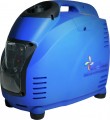Max. power
The maximum power output that the generator can provide.
This power is slightly higher than the nominal (see above), but the maximum performance mode can only be maintained for a very short time - otherwise an overload occurs. Therefore, the practical meaning of this characteristic is mainly to describe the efficiency of the generator when working with increased starting currents.
Let us recall that some types of electrical appliances consume several times more power (and, accordingly, power) at the moment of starting than in the normal mode; this is typical mainly for devices with electric motors, such as power tools, refrigerators, etc. However, increased power for such equipment is needed only for a short time, normal operation is restored in literally a few seconds. And you can estimate the starting characteristics by multiplying the nominal power by the so-called starting coefficient. For equipment of the same type, it is more or less the same (1.2 - 1.3 for most power tools, 2 for a microwave oven, 3.5 for an air conditioner, etc.); more detailed data is available in special sources.
Ideally, the maximum power of the generator should be no less than the total peak power of the connected load - that is, the starting power of equipment with a starting factor greater than 1 plus the rated power of all other equipment. This will minimize the likelihood of overloads.
Motor type
Model name of the engine installed in the generator. Knowing this name, you can, if necessary, find detailed data on the engine and clarify how it meets your requirements. In addition, model data may be needed for some specific tasks, including maintenance and repair.
Note that modern generators are often equipped with
branded engines from famous manufacturers: Honda, John Deere, Mitsubishi, Volvo, etc. Such engines are more expensive than similar units from little-known brands, but this is offset by higher quality and/or solid warranty conditions , and in many cases, the ease of finding spare parts and additional documentation (such as manuals for special maintenance and minor repairs).
Engine size
The working volume of the engine in a gasoline or diesel generator (see "Fuel"). Theoretically, more volume usually means more power, but in fact, everything is not so clear. Firstly, the specific power strongly depends on the type of fuel, and in gasoline units, also on the type of internal combustion engine (see above). Secondly, similar engines of the same power can have different volumes, and there is a practical point here: with the same power, a larger engine consumes more fuel, but by itself it can cost less.
Fuel consumption (50% load)
Fuel consumption of a petrol or diesel generator when operating at half power, and for combined models when using petrol (see “Fuel”).
Fuel consumption usually increases with load. However, generator efficiency is not always linear - fuel consumption may vary disproportionately with different loads. In this case, the approximate amount of fuel consumed by the generator when operating at half power (50% of the rated power) is given. Knowing the fuel consumption and tank capacity, you can at least estimate how long one fill-up will last.
Fuel tank volume
The volume of the fuel tank installed in the generator.
Knowing the fuel consumption (see above) and the capacity of the tank, you can calculate the operating time on one gas station (if it is not indicated in the specifications). However, a more capacious tank is also more bulky. Therefore, manufacturers choose tanks based on the general level and "voracity" of the generator — in order to provide an acceptable operating time without a significant increase in size and weight. So in general, this parameter is more of a reference than practically significant.
As for the numbers, in low-power models, tanks are installed for
5 – 10 liters, or even
less ; in heavy professional equipment, this figure can
exceed 50 liters.
USB charging port
The generator has
a USB connector(one or more) for charging various devices. Most modern smartphones and tablets can be charged from USB, and this charging method is also found in many other equipment - from cameras and flashlights to electric screwdrivers and radio-controlled models. The standard supply voltage through this connector is 5 V, but the power may be different, it should be specified separately.
Output 12 V
Existence in the generator of an
output with a direct current and voltage of 12 V. The main function of this output is to charge car batteries, as well as power devices originally intended for cars (recall, 12 V is the standard voltage of on-board networks in cars).
The following types of 12-volt outputs are found in generators:
- Terminals. Terminals are used to connect wires directly without using any plugs. This connection is the most reliable.
- Socket. Socket outlet for a plug with two flat pins, designed to connect 12-volt consumers. Holes in sockets come in different layouts, which you need to pay attention to.
- Cigarette lighter. The so-called "car socket", which in many cars is combined with a cigarette lighter socket (hence the name). Such connectors are used to power various automotive devices and accessories.
Noise level
The noise level produced by the generator when operating in normal mode. The less noise the unit makes, the more comfortable it is to use, the closer it can be placed to people, but the higher its price, all other things being equal.
It is also worth considering that generators with internal combustion engines are, in principle, quite noisy equipment. Thus, even the "quietest" units produce
< 70 dB - this is the volume of a conversation in tones from medium to high. Accordingly, it is recommended to install the device remotely from the place of use. At the same time, we note that the noise level is not directly related to the power: for example, among units of 80 dB and more, there are both heavy and relatively low-power models.
Sound level (7 m)
Sound pressure level in decibels at a distance of 7 m between the noise source and the ear of the equipment operator. Since people do not work in the immediate vicinity of the generator, the parameter will be useful for estimating the noise level at a distance. For example, current European Union regulations require that the sound power of generating sets with a power of more than 2 kW does not exceed 97 dB — at a distance of 7 m, the noise from the generator engine will correspond to a sound pressure of about 72 dB.

